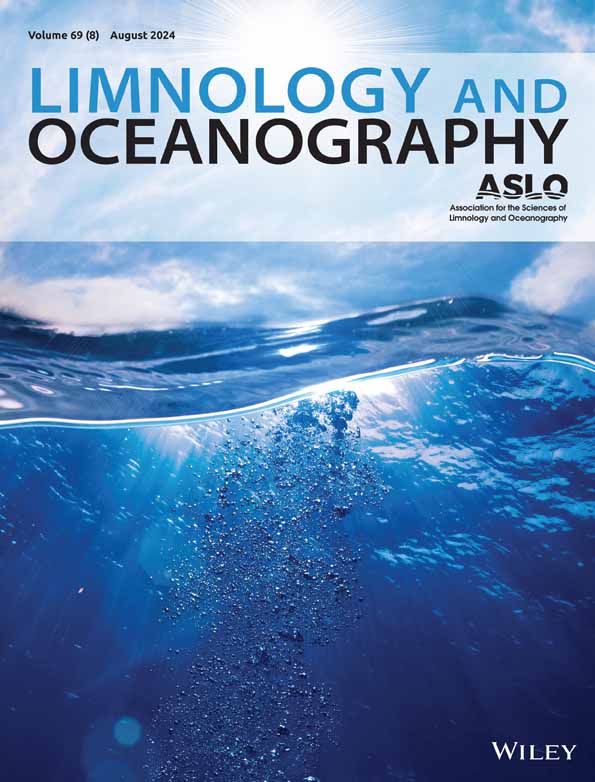单菌落的元素分析揭示了灰尘中接触依赖的铁吸收
IF 3.7
1区 地球科学
Q1 LIMNOLOGY
引用次数: 0
摘要
沉积在营养物被剥夺的海洋表面的气溶胶尘埃可以促进浮游植物的生长和海洋碳的吸收。矿物质溶解度低限制了粉尘营养物质的生物利用,从而有利于主动溶解粉尘的浮游植物。普遍存在的菌落形成、固定N2的蓝藻Trichodesmium专门利用粉尘营养物质,在自然种群中发现了几种粉尘溶解途径。利用台式微x射线荧光成像仪对红海受尘埃影响的天然菌落的元素组成(即配额)进行了研究。我们还研究了在有灰尘和营养物的孵育过程中菌落配额的变化。考虑到群体间的变异,我们分析了106个个体群体。由于颗粒经常出现在菌落表面,我们仔细分析了所有图像,从菌落配额中去除了尘埃颗粒信号。通过观察菌落的铁(Fe)和磷(P)配额,我们观察到菌落间变异和对粉尘的反应的对比模式,这可能反映了不同的营养来源——铁来自粉尘,磷来自溶解相。从灰尘中摄取铁被反复观察到,但只有在菌落-矿物相互作用下,表明接触依赖于活性溶解。尘埃在铁营养中的作用也从溶解的铁络合对铁配额的轻微影响中可见一斑。磷配额对磷的添加或去除反应迅速,但对粉尘没有反应。在一个季节内采集的自然菌落铁配额具有异质性,而磷配额具有同质性,这进一步支持了它们的不同来源。在预测富颗粒和受尘埃影响的海洋环境中,铁藻华的动态应该考虑到它溶解铁矿物的能力。本文章由计算机程序翻译,如有差异,请以英文原文为准。
Contact‐dependent iron uptake from dust revealed by elemental analysis of single Trichodesmium colonies
Aerosol dust deposited on the nutrient‐deprived surface ocean can boost phytoplankton growth and oceanic carbon uptake. Low mineral solubility restricts the biological utilization of dust‐nutrients, thereby benefiting phytoplankton that actively dissolve dust. The ubiquitous colony‐forming, N2 ‐fixing cyanobacteria Trichodesmium specialize in dust‐nutrient utilization, with several dust‐dissolution pathways identified in natural populations. Studying active dust dissolution by Trichodesmium , we surveyed the elemental composition (i.e., quotas) of natural colonies from the dust‐impacted Red Sea using a benchtop micro‐x‐ray fluorescence imager. We also examined changes in the colonies' quotas during incubations with dust and nutrients. Accounting for inter‐colony variability, we analyzed 106 individual colonies. Since particles often appeared on the surface of colonies, we carefully analyzed all images, removing dust particle signals from colony quotas. Focusing on the colonies' iron (Fe) and phosphorus (P) quotas, we observed contrasting patterns of inter‐colony variability and responses to dust, likely reflecting distinct nutrient sources—Fe sourced from dust and P sourced from the dissolved phase. Iron uptake from dust was repeatedly observed, but only upon colony–mineral interactions, indicative of contact‐dependent active dissolution. The role of dust in Fe nutrition was also evident from the minor impact of dissolved Fe complexation on Fe quotas. Phosphorus quotas responded rapidly to P addition or removal, but not to dust. Natural colonies collected over a season had heterogeneous Fe quotas but homogeneous P quotas, further supporting their distinct sources. Predictions of Trichodesmium 's bloom dynamics in particle‐rich and dust‐impacted ocean environments should incorporate its ability to dissolve Fe‐minerals.
求助全文
通过发布文献求助,成功后即可免费获取论文全文。
去求助
来源期刊

Limnology and Oceanography
地学-海洋学
CiteScore
8.80
自引率
6.70%
发文量
254
审稿时长
3 months
期刊介绍:
Limnology and Oceanography (L&O; print ISSN 0024-3590, online ISSN 1939-5590) publishes original articles, including scholarly reviews, about all aspects of limnology and oceanography. The journal''s unifying theme is the understanding of aquatic systems. Submissions are judged on the originality of their data, interpretations, and ideas, and on the degree to which they can be generalized beyond the particular aquatic system examined. Laboratory and modeling studies must demonstrate relevance to field environments; typically this means that they are bolstered by substantial "real-world" data. Few purely theoretical or purely empirical papers are accepted for review.
 求助内容:
求助内容: 应助结果提醒方式:
应助结果提醒方式:


